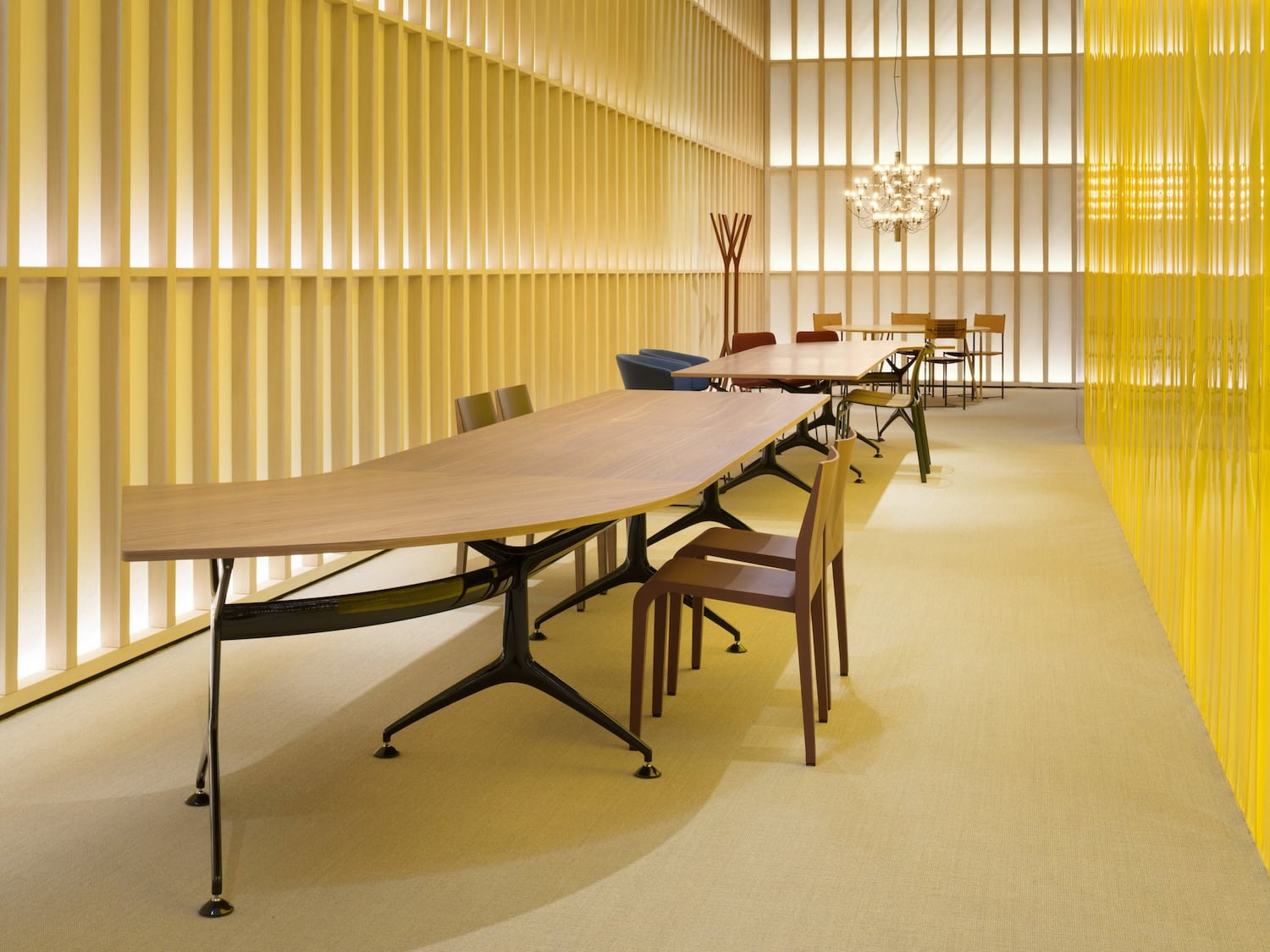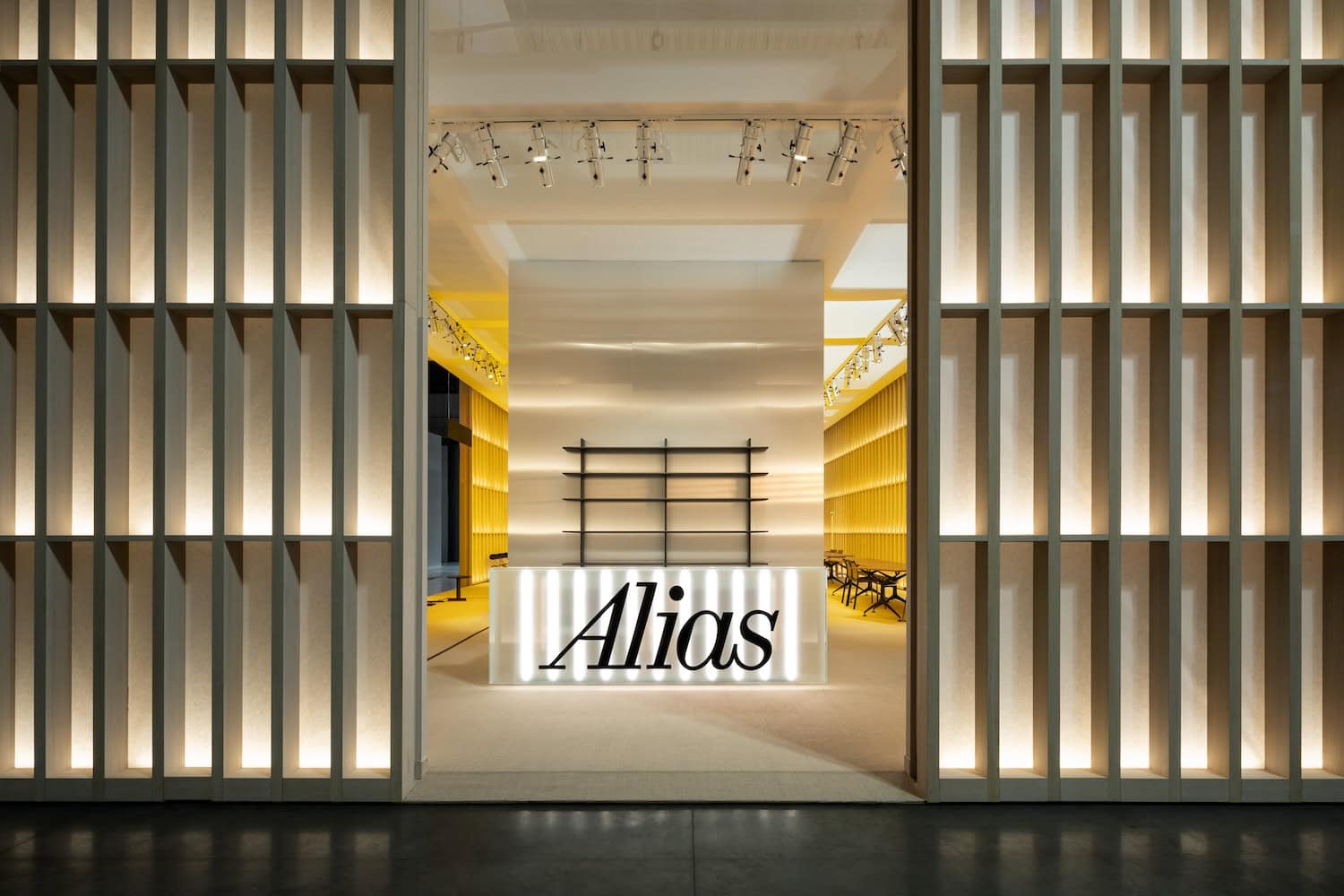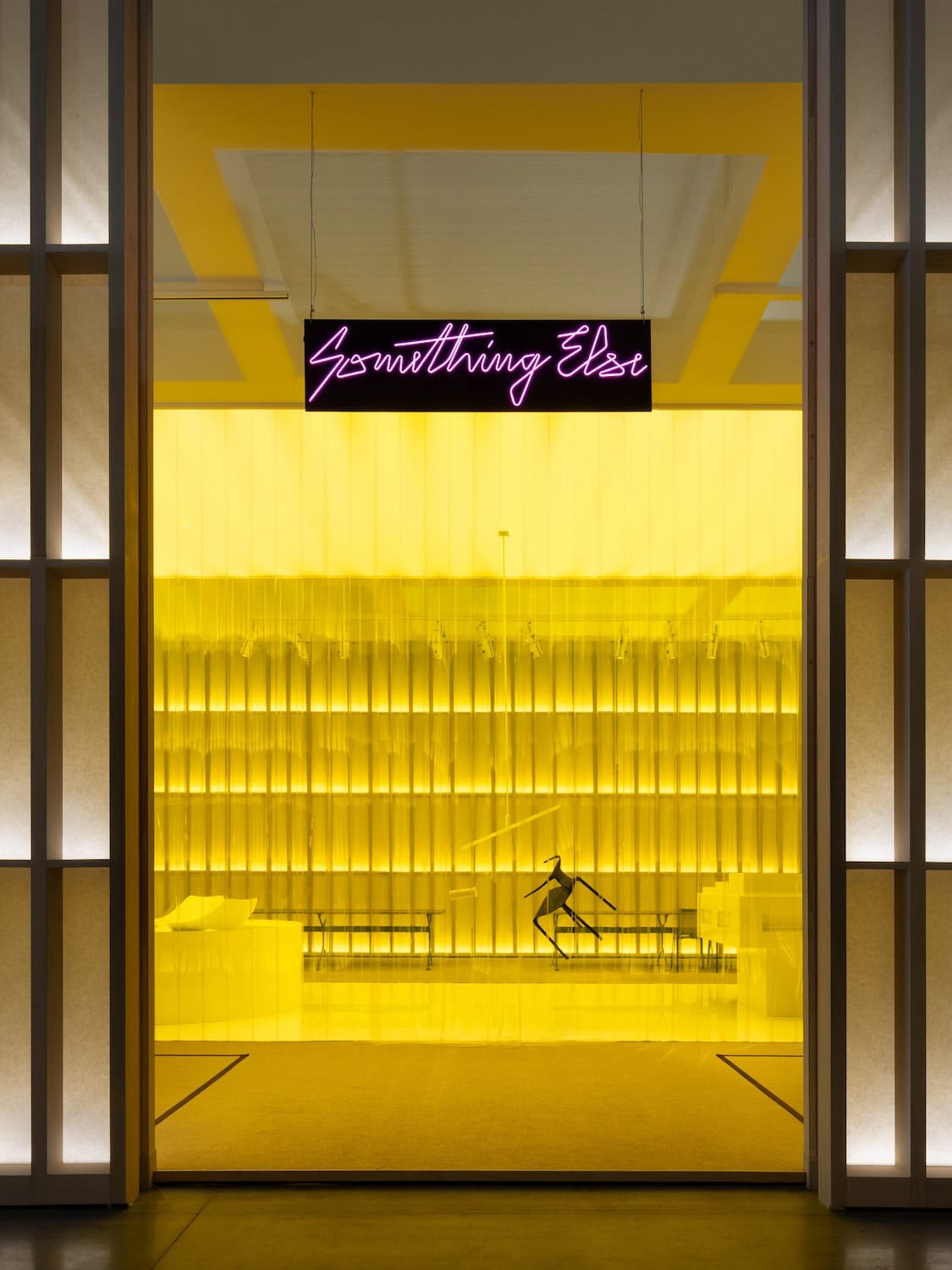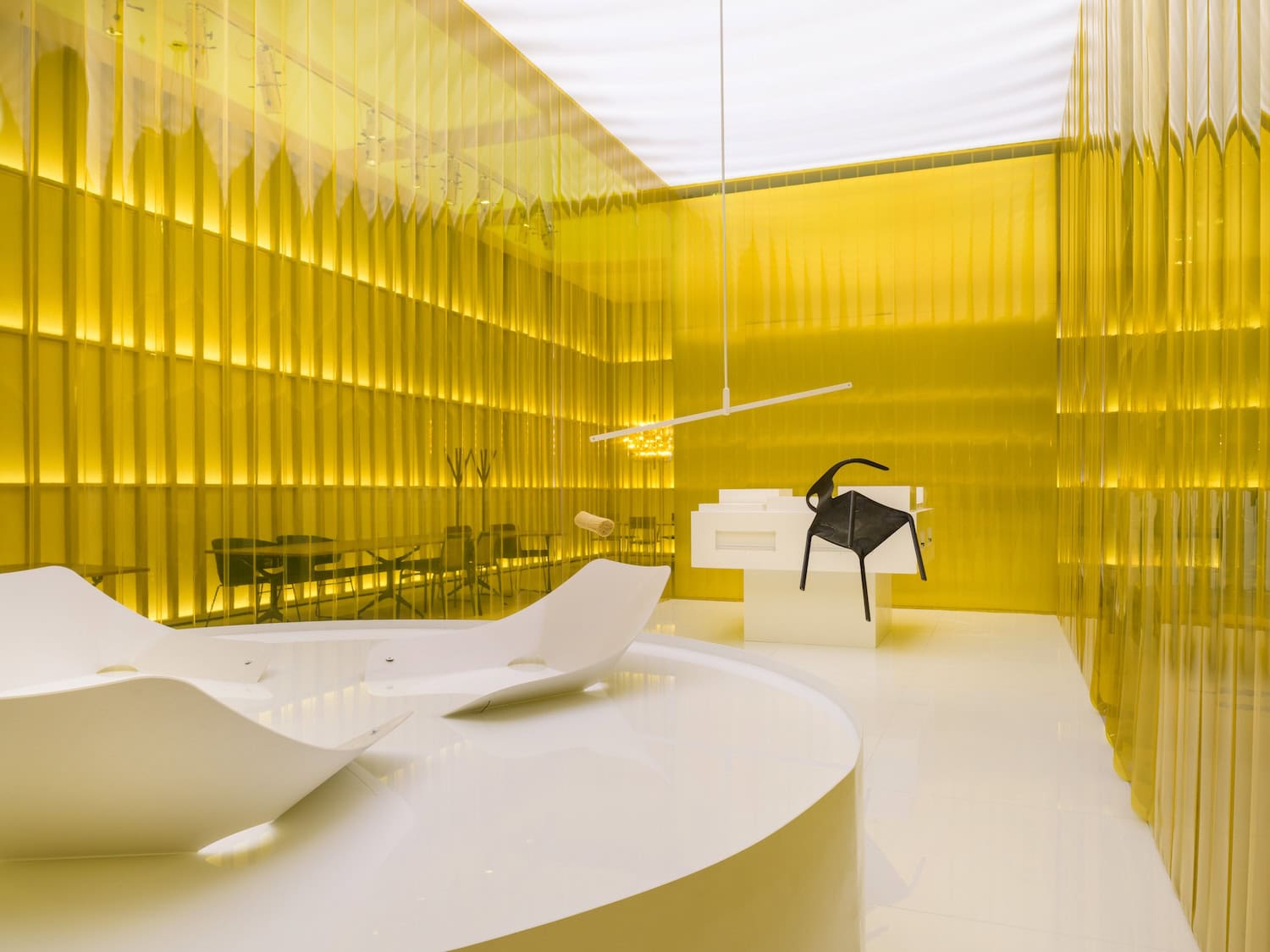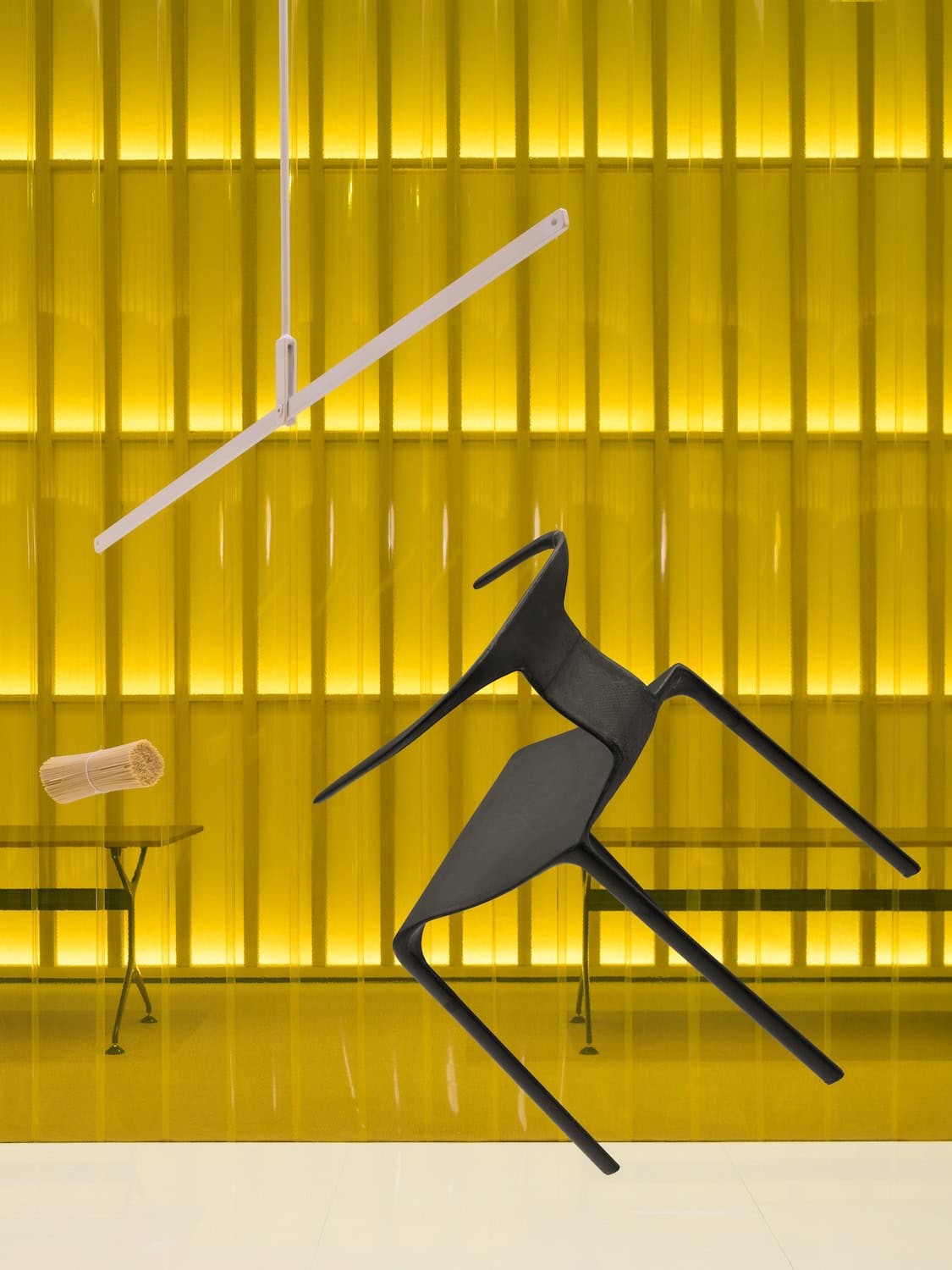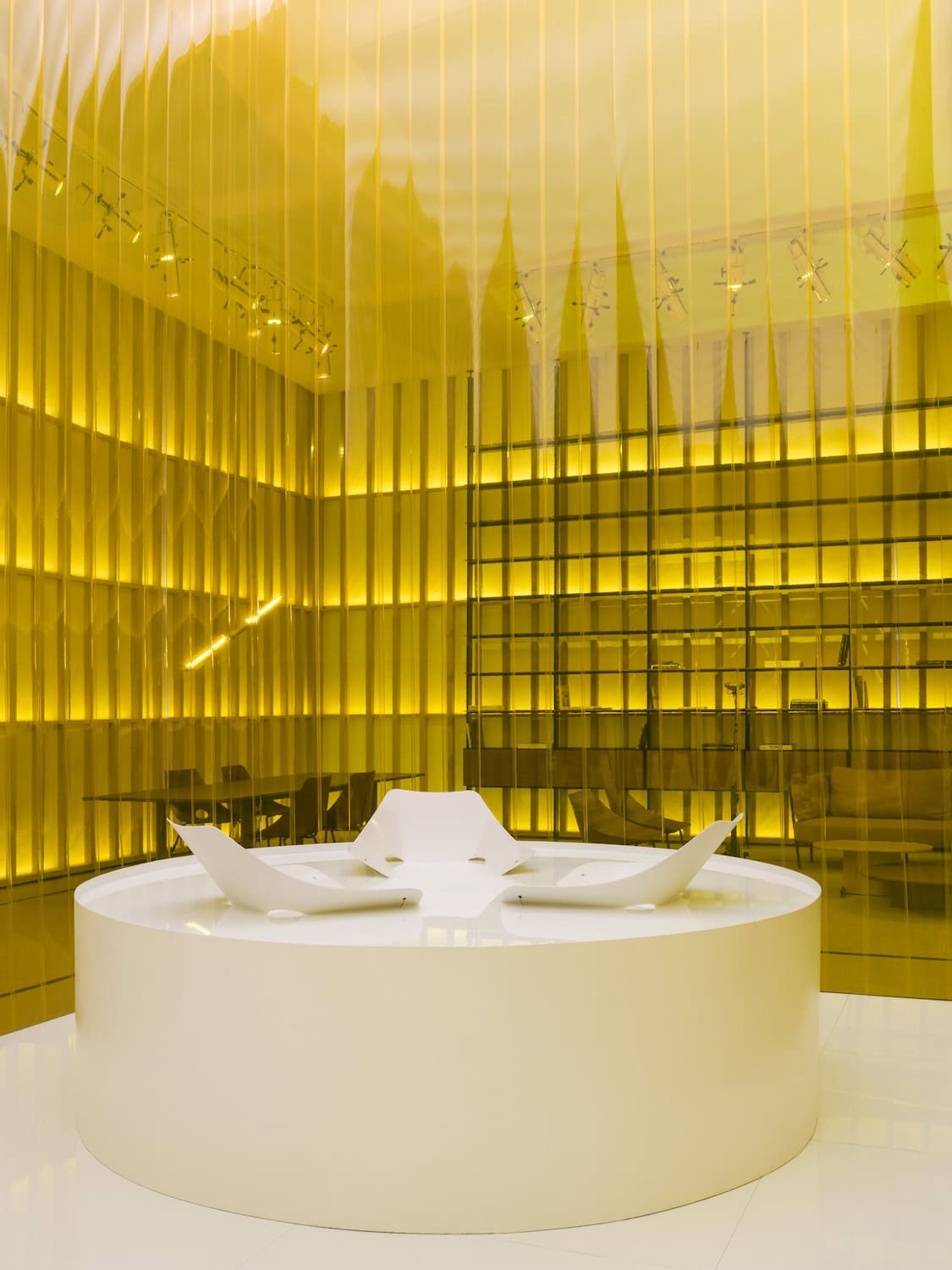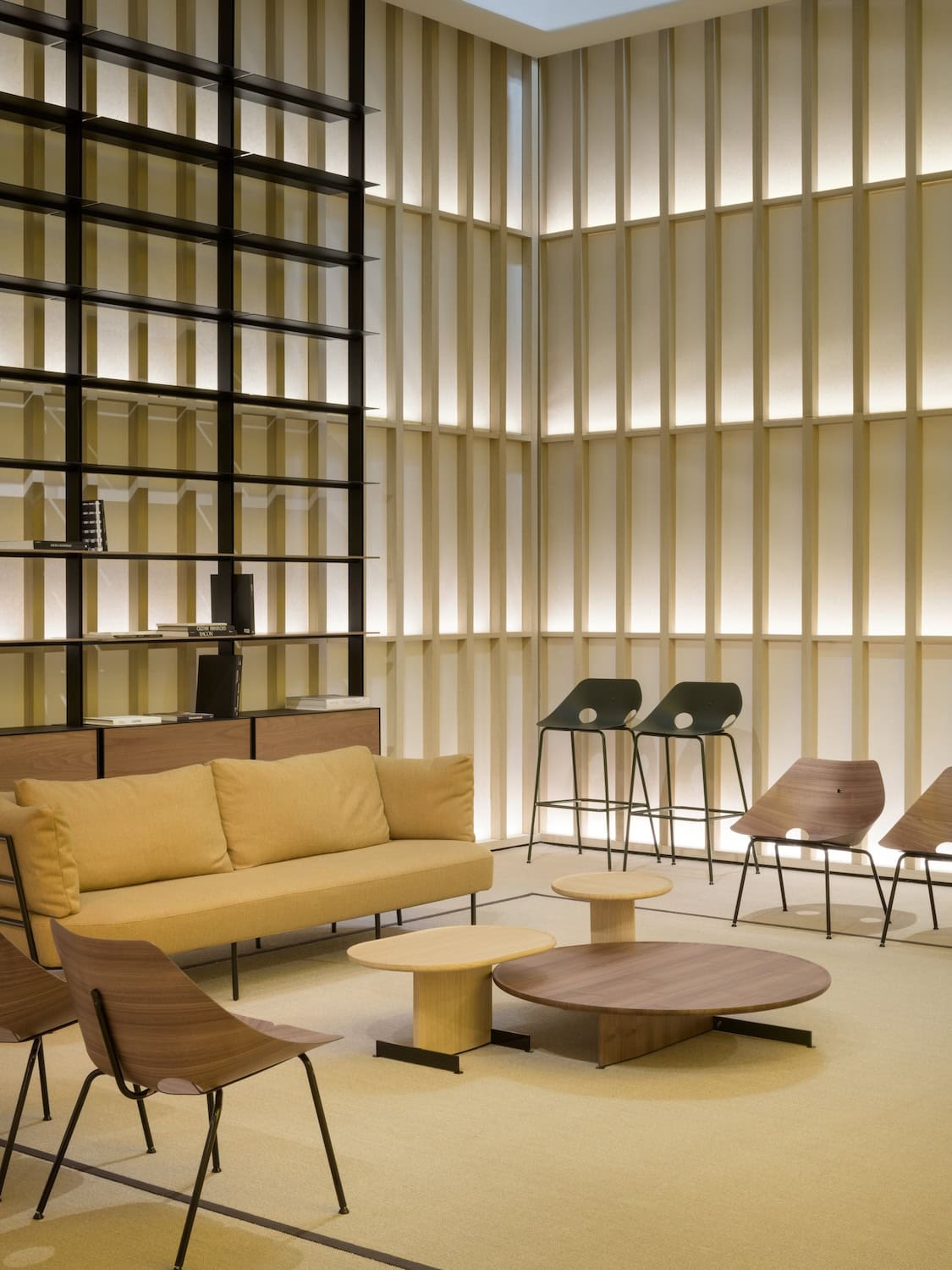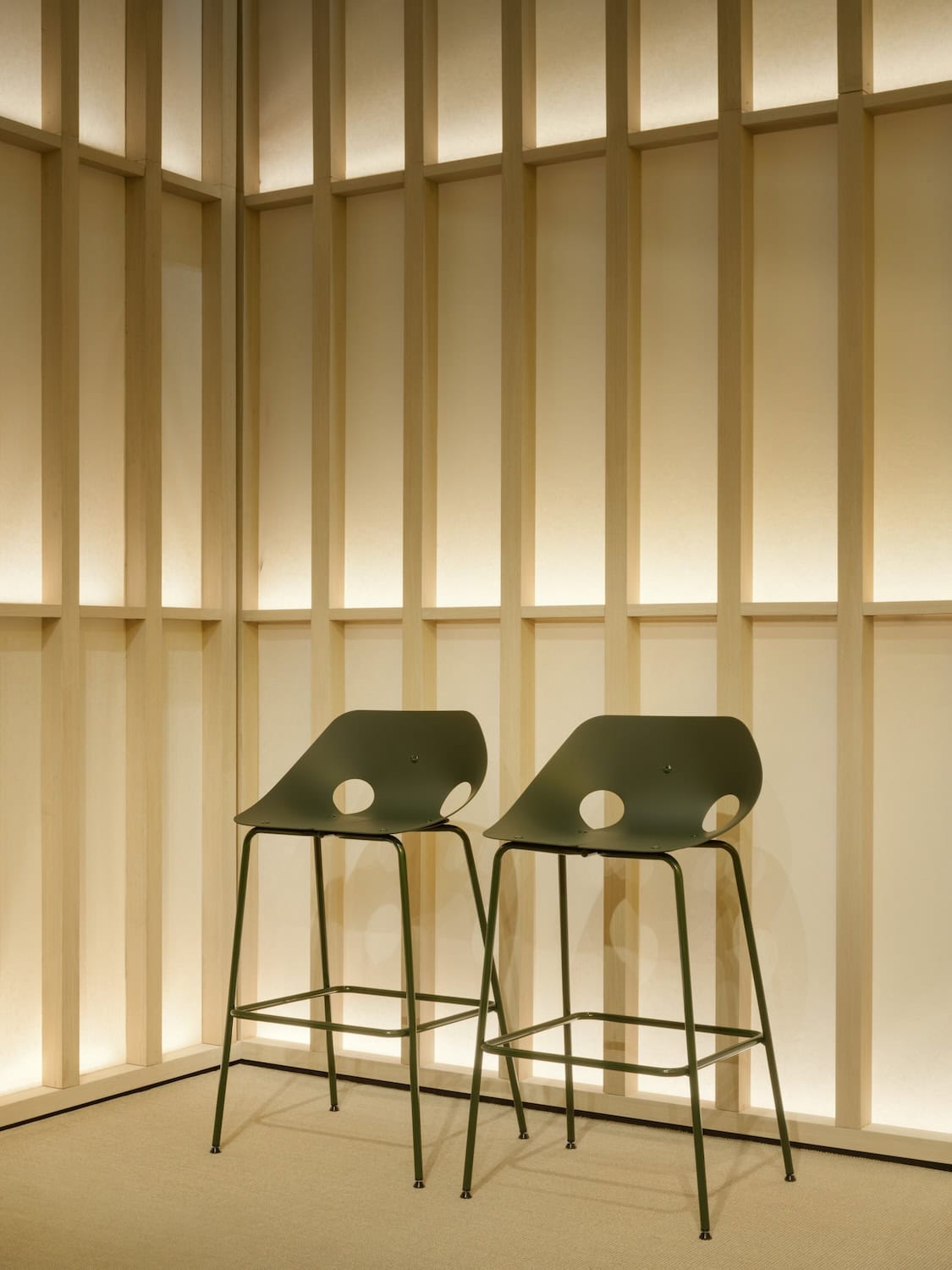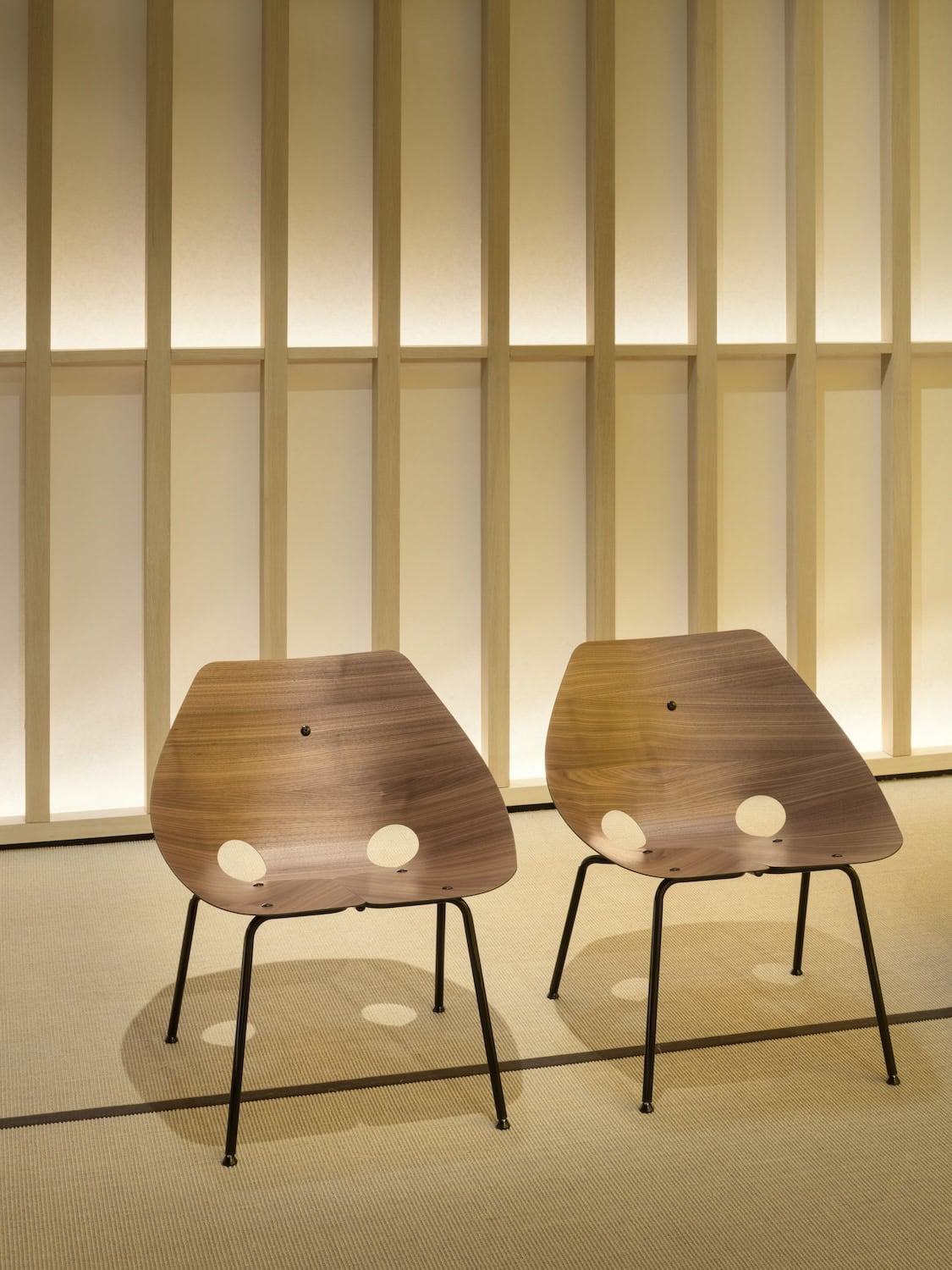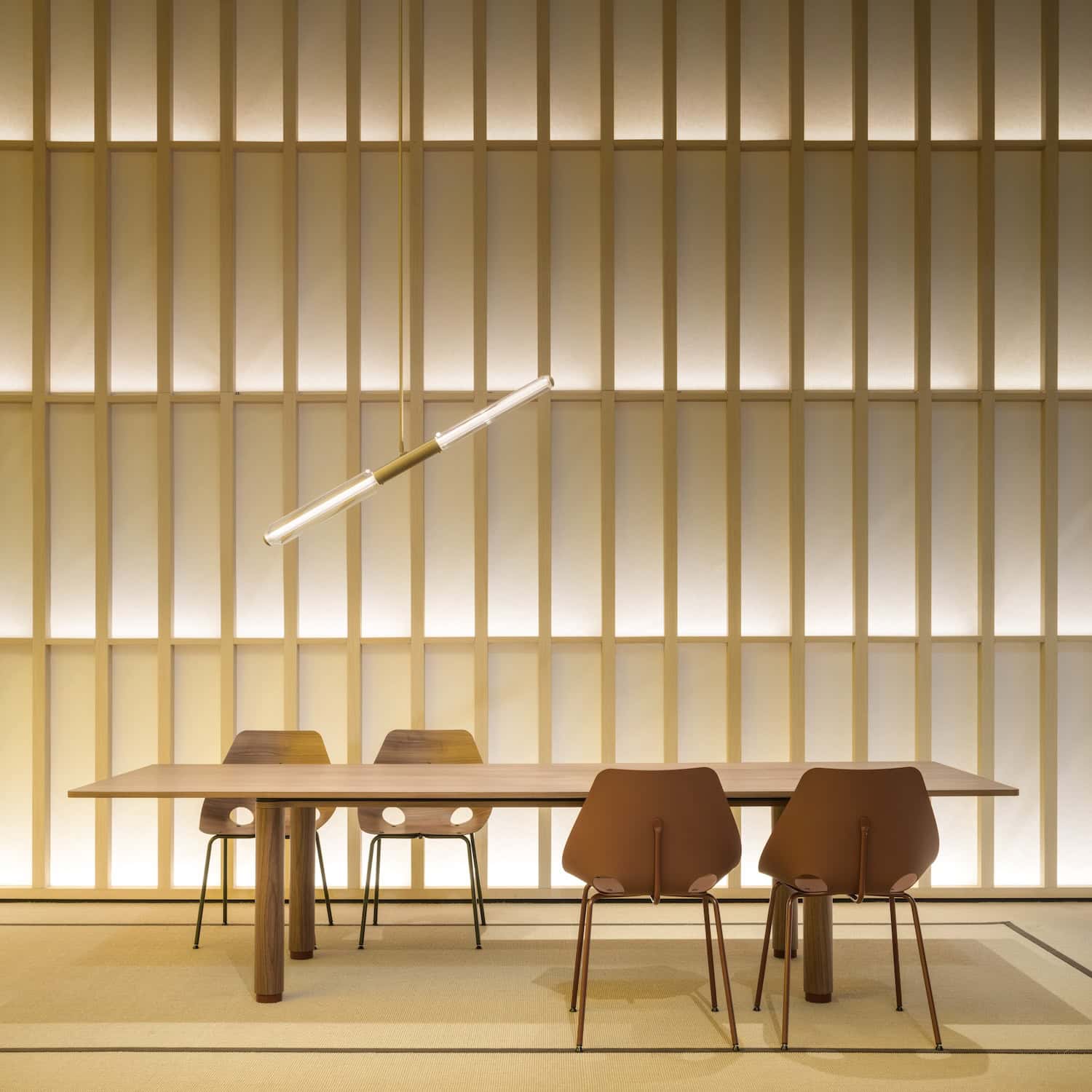The metro to Rho Fiera is a wild ride without seats. On my way from the centre of Milan to the Salone del Mobile, my hope is that the unpleasant architecture of Milan’s subway will at some point welcome me. But the crowd is kinetic and the bags are full of press releases. I think I would like this crowded space to be something else. I don’t want to be somewhere else, I want to be surrounded by something different: that’s how much design can influence our lives. In other words, when we feel cramped in a space, are we really looking for an altrove (to be somewhere else) or are we just longing for better design?
The stand of the historic Italian brand Alias at the Salone del Mobile in Milan is all about the secular and radical philosophy of the search for “Something Else”: in design, in life, in people. Four projects in collaboration with contemporary designers Daniel Rybakken, Alfredo Haeberli and Patrick Norguet are presented alongside references to historical pieces such as the Light Light chair by Alberto Meda, which made Alias a pioneer of avant-garde design. Daniel Rybakken is the youngest of the three designers working with Alias. His height-adjustable table, Nastro, and the Lira chair are all about a low-fi approach to design. Rybakken combines a strict selection in materials and shapes with an analogue way of thinking about the everyday use of the products.
Alessia Baranello: What interested me most about the Nastro collection was its analogue nature. The use of a toothed belt and pulleys to lift the table reminded me of old tape recorders or even famous designer typewriters like the Olivetti. Do you think that the more analogue a product is, the closer it can get to people?
Daniel Rybakken: For me, analogue is in a way the new luxury. There’s something about touching and interacting with objects that people now want more than a touch screen. Also, mechanics is something the public understands more easily: when things become electronic or digital, people often lose control over objects.
AB: Are there any reasons other than popular preference for this analogue choice?
DR: With these pieces for Alias I wanted to make a statement that innovation is not always technological innovation, it can also come from simplicity and recombining old forms, materials and knowledge to create something new. I feel that more and more for some designers, innovation is just about finding new materials or new technologies. These pieces, on the other hand, use traditional techniques and traditional materials like wood and steel. But you still end up with something very different from what’s on the market.
AB: Can you expand a little bit on how the Nastro table works?
DR: The belt you see is a belt used in car engines. In the car it runs all the time, even when the car is stopped, and it will last ten, fifteen years. In a situation like this, where you move it analogously with your hands to adjust the table, it can last forever.
AB: When did you first think of this mechanism, which has now even been patented?
DR: In 2020, during the lockdown. People moved their offices home and in Scandinavia standing desks or adjustable tables became the norm. They are very industrial looking objects, kind of ugly and expensive. I wanted to make something more thoughtful, designed to come closer to these new habits that merge working and living spaces.
AB: The Lira chair immediately reminded me of one of your most radical projects: the Ypsilon bench, a piece of street furniture made in collaboration with the Scandinavian design brand Vestre. For me, what these two products have in common is a search for reduction: they both reduce the act of sitting to its simplest form. Once again, wood and steel are the protagonists of these two projects.
DR: The base of the Lira chair is made of standard L-section steel – the sort available in any DIY shop. The front legs are removed, and then a brutalist plank of wood is added, with not so much refinement. For both products, it was important to avoid material abuse. The Ypsilon bench and the Lira chair also have in common the simple fact that I can name them and describe them with a single letter. This says a lot about how simple but thoughtful shapes can create good design. So now the question is: which letter will come next?
Patrick Norguet loves Italy, even though he keeps his studio in Paris, and likes to think of design as a game. Like Daniel Rybakken, he told me how much he loves working with Italian brands because design in Italy is much more fun, spicy and fast. That’s why he has collaborated with Alias many, many times: from the Kobi chair to the wooden seat kayak that won the Compasso d’Oro in 2016. For this occasion, he is presenting a set of three coffee tables with a very sculptural feel.
AB: The first thing I would like to ask you, since you have a strong relationship with Italy and Italian design brands, is why you chose the name Savoy for this collection.
Patrick Norguet: Savoy is obviously a reference to the heritage of Italian history. We started discussing this project with Alias last year, in what is now a ten-year collaboration. We wanted a table that was classically modern, simple but sharp and clever. And when we talked about the name, we thought that Savoia had this classic but modern feel to it, that it would fit well with the Italian DNA of Alias.
AB: The Savoy coffee tables have a very unique and sculptural appearance, but like a chameleon they change shape every time you move around them. They reminded me of the architectural quality of some of the art exhibitions designed by the great Italian architect and designer Carlo Scarpa.
Patrick Norguet: I know Carlo Scarpa’s work, of course, and yes, these pieces have an architectural quality. For me, design is nothing: I draw a horizontal line and a vertical line, but after that what makes the difference is how you combine materials, how you refine them and with what intention. In the Savoy tables you have a piece of wood that is finished to give a feeling of aerodynamics, with a profile that is reminiscent of an aeroplane. The wood elements are the result of different types of wood being pressed together, so you see all the grains going in different directions. You can create this effect artificially and many companies do, but we wanted to make it more sincere. Then, the combination wood-steel gives the Savoy tables that straightforward and uplifting contrast I was looking for.
AB: You have a long history of working with Alias. What do you think is the brand’s main strength?
PN: Alias is a very cool company. When you see their catalog, their products: it’s just gorgeous. The business has not always been easy but, since last year, the company has restarted to build its classic DNA. My story with Alias is mainly a people’s story and my first and main inspiration in design are always people. Without them and the energy to do something special together, probably putting a new product in the market would be useless.
AB: In a market and a world full of products, why another object?
PN: To me it is important to leave to the world something with a timeless character and to start a love story with the brand and its people. We designers have to keep loving the companies we are working with. This is modernity, the rest is bullshit.
Alfredo Haeberli has matched his T-shirt to the colour of one of his Time chairs, and he refuses to tell me if it’s a coincidence. His plum t-shirt says “Never fade away”. I think he is a man of obsessions: with time, with folding, with reaching very difficult things and, obviously, with never fading away.
AB: The original idea for the Time seats was that they would be made from a die-cut panel of wood and compound materials. In this new version, however, you have used a new material, ABS, a thermoplastic polymer that is more resistant and stiffer than conventional ones. What has changed?
Alfredo Haeberli: The idea behind the Time collection has always been the one of creating a comfortable seat with the least material usage possible. I searched for a material and for a movement that could – starting from a flat sheet of only two millimeters–create a tridimensional, resistant and comfortable shape for a chair. ABS is kind of a unique material in this sense. It helps you not to have an origami-sharp effect, but gives the seat a curved and morbid appearance.
AB: Was it difficult to find the perfect shape that could be folded to look like a piece of paper or cardboard without losing its strength?
AH: Absolutely, so much so that today we’ve even been granted a patent for this product. It is like making an ergonomic, interesting dress out of a single piece of fabric. I made about fifteen models to find the final shape. You can’t see the whole process, because at first it looks like a very normal chair, but getting to the Time chair has been an invisible work going on since 2017. Good ideas take time to develop and they also conquer time if they are really good.
AB: For me, the Time chairs are also visually reminiscent of some scientific representations of time and space, such as those aimed at black holes. In those kinds of representations, there is a main layer that is flat, and then as time goes on it becomes curved or torn by some external forces. Did you find any inspiration in science for these pieces?
AH: With the installation we made together with David Lopez Quincoces and Francesco Meda for this stand at the Salone del Mobile, we wanted to mimic exactly this kind of shredding movement, to help people understand what the Time chairs are. That’s why the flat ABS panels are moved by a water turbine. I find it extremely fascinating that something so flat can create three-dimensionality. And what I find even more striking about this process is that it appears to be digital, but it is all done by hand: the drawings, the forming, the bending system and the screwing.
AB: How would you define the concept of “Something Else” in the design field?
AH: I think design often wants to be too fashionable, to follow trends. I’m interested in fashion as an inspiration, but I don’t think design is the right industry to follow fashion or trends. That’s why if the market wants big sofas, I make them even smaller. That’s why everything I’ve designed in the last twenty years is still in production and on the market. You have to look for durability, you have to give your products the ability to conquer Time and to do that you cannot follow trends.
